 Bangladesh, with a huge population (estimated nearly 165 million in 2017) and an abundance of low-and semi-skilled workers, faces a major development challenge of creating productive and remunerative employment opportunities to raise incomes, reduce poverty and make the transition to an aspired higher-middle-income-country status at the earliest. For the purpose, along with developing entrepreneurship, a key concern is to provide skills among the vast majority of the labour force who are already employed or seeking work that would enable them to keep up with factors like structural changes in the economy brought about by urbanisation, technological change, and shifting patterns of consumer demand.
Bangladesh, with a huge population (estimated nearly 165 million in 2017) and an abundance of low-and semi-skilled workers, faces a major development challenge of creating productive and remunerative employment opportunities to raise incomes, reduce poverty and make the transition to an aspired higher-middle-income-country status at the earliest. For the purpose, along with developing entrepreneurship, a key concern is to provide skills among the vast majority of the labour force who are already employed or seeking work that would enable them to keep up with factors like structural changes in the economy brought about by urbanisation, technological change, and shifting patterns of consumer demand.
Moreover, in a low-income country like Bangladesh, there are many conditions under which skill-development is likely to pay off, such as rapid economic growth and job creation for realising the benefits of skill development, emphasis on good-quality basic education for all as a foundation for skill development, bringing the demand side of the labour market together with the supply side to ensure the quality and relevance of specific skills, and efforts to reach the disadvantaged segments of the population and labour groups through providing other support services.
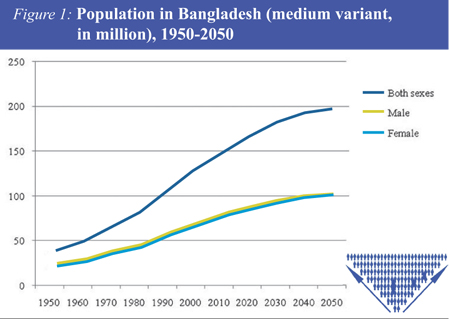 The government adopted a comprehensive National Skills Development Policy in 2011to guide skill-development strategies and coordinate skill-training in the country. The policy covers both formal and non-formal vocational, technical and skill-based education and training for wage employment and/or self-employment including (i) pre-employment and livelihood skill training, including technical and vocational education and training (TVET), apprenticeships and school-based TVET, (ii) education and training for employed workers, including workplace training, and (iii) employment-oriented and job-related short courses for both domestic and international markets. The policy also recognises the need of providing skills to enhance employability and secure safe and decent work for the huge labour force currently working in the informal economy.
The government adopted a comprehensive National Skills Development Policy in 2011to guide skill-development strategies and coordinate skill-training in the country. The policy covers both formal and non-formal vocational, technical and skill-based education and training for wage employment and/or self-employment including (i) pre-employment and livelihood skill training, including technical and vocational education and training (TVET), apprenticeships and school-based TVET, (ii) education and training for employed workers, including workplace training, and (iii) employment-oriented and job-related short courses for both domestic and international markets. The policy also recognises the need of providing skills to enhance employability and secure safe and decent work for the huge labour force currently working in the informal economy.
While proper implementation of the present policies for skills development will no doubt make significant contributions towards reaping the demographic dividends, Bangladesh also needs to transform its labour force in the medium term for meeting the challenges stemming from a knowledge economy for which the workforce should be dynamic, highly-skilled and broad-based in competence. Alongside meeting the current requirements of education and skills, it is also time Bangladesh prepared its labour force for addressing the challenges of the country's future vision. In this context, demographic changes that the country will undergo in the coming decades provide wide opportunities for the age-groups who are in their infancy today to realise their potentials in the envisaged knowledge economy of the future if right policies are integrated with the current policy initiatives.
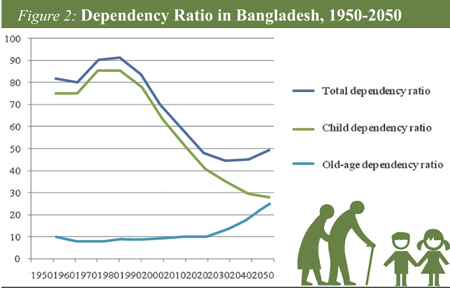 For the medium term, Bangladesh needs to realise the importance of early childhood development of the present generation of children as a key element of education and skill development of the future labour force. In this context, in view of the present education and health status of the country's children, pre-schooling and early health are critical areas to focus in present policies. It is widely recognised that early childhood development significantly affects cognitive and non-cognitive development of children and their future employability and productivity which are important considerations in a knowledge economy. In Bangladesh, the focus on early education and health systems is necessary for two compelling reasons. First, early education and health remain somewhat neglected in the country's human capital discourse; and second, it is widely believed that the country's early education and health systems are grossly inadequate, inefficient, and inequitable.
For the medium term, Bangladesh needs to realise the importance of early childhood development of the present generation of children as a key element of education and skill development of the future labour force. In this context, in view of the present education and health status of the country's children, pre-schooling and early health are critical areas to focus in present policies. It is widely recognised that early childhood development significantly affects cognitive and non-cognitive development of children and their future employability and productivity which are important considerations in a knowledge economy. In Bangladesh, the focus on early education and health systems is necessary for two compelling reasons. First, early education and health remain somewhat neglected in the country's human capital discourse; and second, it is widely believed that the country's early education and health systems are grossly inadequate, inefficient, and inequitable.
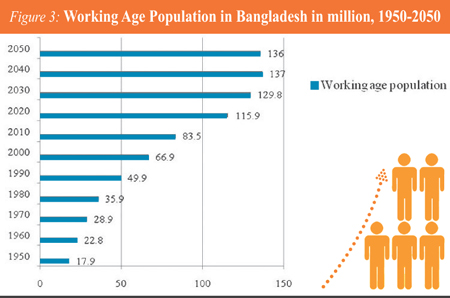
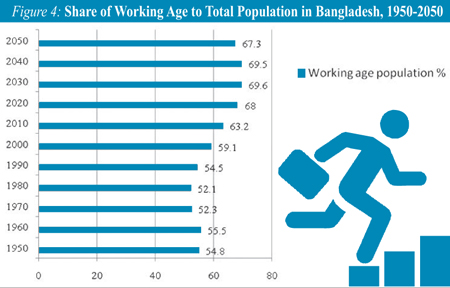
The Global Human Capital Report 2017, published by the World Economic Forum, examines how the countries are leveraging human capital and preparing their workforces for meeting the demands of the competitive world in future. The Index interprets human capital as the knowledge and skills people possess that enable them to create value in the global economic system. It is not defined solely through formal education and skilling. It can be enhanced over time, growing through use-and depreciating through lack of use-across people's lifetimes. Human capital is measured across four thematic dimensions-capacity, deployment, development and know-how to capture the full human- capital-potential profile of a country. The capacity sub-index quantifies the existing stock of education across generations; the deployment sub-index covers skills application and accumulation of skills through work; the development sub-index reflects current efforts to educate, skill and up-skill the student body and the working-age population; and the know-how sub-index captures the breadth and depth of specialised skills use at work.
Bangladesh's ranking in the overall Index is 111 out of 130 countries; 104 in capacity sub-index, 105 in deployment sub-index, 100 in development sub-index and 104 in know-how sub-index. This shows the extremely disadvantaged situation of the country in terms of human capital which, if remains unchanged, will make the country's transition to the middle-income category difficult to realise within the stipulated time.
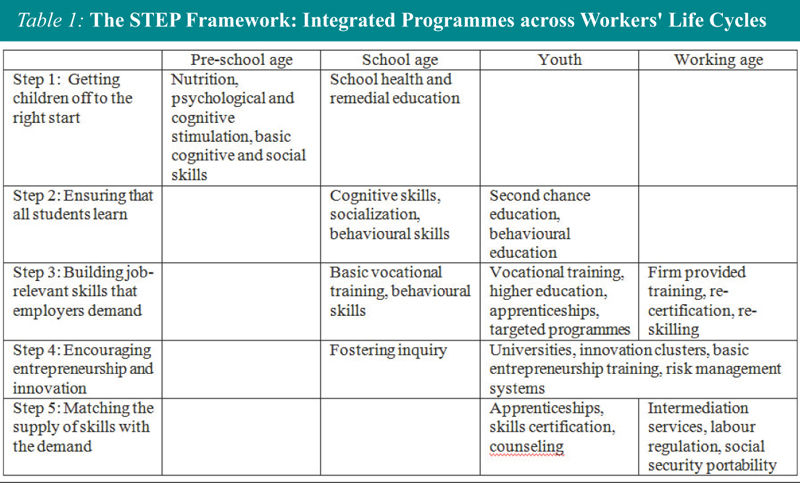 Bangladesh is the eighth-most-populous country in the world with a total population of nearly 165 million, as of 2017, which is projected to grow to more than 202 million in 2050 (Figure 1).Although the large size of population has traditionally been considered a bottleneck for rapid growth in a low-income country, the recent development literature highlights two-way positive interactions between population and economic growth, especially in terms of its changing age structure. Changes in age structure lead to decline in dependency ratio which favours higher economic growth if supportive policies enhance employability prospects of the labour force. Total dependency ratio is defined as the ratio of population 0-14 and 65+ age to population 15-64 age; while child- dependency ratio is the ratio of population 0-14 per 100 population 15-64; and old-age-dependency ratio is the ratio of population 65+ per 100 population 15-64. However, in Bangladesh, the standard dependency ratio may not reflect the true picture due to widespread prevalence of child labour which is very common with an estimated 4.5 million or more than 10 per cent of children aged below 14 in the labour force.
Bangladesh is the eighth-most-populous country in the world with a total population of nearly 165 million, as of 2017, which is projected to grow to more than 202 million in 2050 (Figure 1).Although the large size of population has traditionally been considered a bottleneck for rapid growth in a low-income country, the recent development literature highlights two-way positive interactions between population and economic growth, especially in terms of its changing age structure. Changes in age structure lead to decline in dependency ratio which favours higher economic growth if supportive policies enhance employability prospects of the labour force. Total dependency ratio is defined as the ratio of population 0-14 and 65+ age to population 15-64 age; while child- dependency ratio is the ratio of population 0-14 per 100 population 15-64; and old-age-dependency ratio is the ratio of population 65+ per 100 population 15-64. However, in Bangladesh, the standard dependency ratio may not reflect the true picture due to widespread prevalence of child labour which is very common with an estimated 4.5 million or more than 10 per cent of children aged below 14 in the labour force.
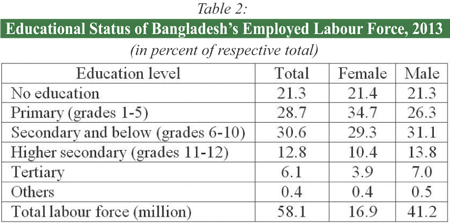 The initial decline in dependency ratio starts with a demographic transition from high to low birth and death rates which results in demographic dividend for the economy that continues until the share of working-age population reaches the peak. Afterwards, the dependency ratio starts rising due to ageing, that is, increasing proportion of people in 65+ age which raises the old-age dependency ratio. During this phase of population dynamics, a country can reap a second demographic dividend over an infinite time horizon if high income levels can be maintained and people accumulate adequate savings and assets for their retirement. However, the benefits of these demographic dynamics can only be realised if human capital can play its due role in economic growth and development.
The initial decline in dependency ratio starts with a demographic transition from high to low birth and death rates which results in demographic dividend for the economy that continues until the share of working-age population reaches the peak. Afterwards, the dependency ratio starts rising due to ageing, that is, increasing proportion of people in 65+ age which raises the old-age dependency ratio. During this phase of population dynamics, a country can reap a second demographic dividend over an infinite time horizon if high income levels can be maintained and people accumulate adequate savings and assets for their retirement. However, the benefits of these demographic dynamics can only be realised if human capital can play its due role in economic growth and development.
Demographic transitions across the world suggest that the low-income countries have high child-dependency ratio and low old-age-dependency ratio while the situation is reverse in high-income countries. As income rises, child- dependency ratio declines while old-age-dependency ratio rises in low-income countries. In 2015, total dependency ratio in low-income countries was estimated to be 84.8 per cent in contrast to 50.5 per cent in high-income countries. In the low-income countries, child-dependency ratio is 78.5 per cent and old-age-dependency ratio is 6.3 per cent while these ratios are 26.0 per cent and 24.5 per cent respectively in high-income countries.
It may, however, be argued that, despite a high total dependency ratio in the low-income countries relative to the high-income ones, the composition of the dependency ratio (with a high share of child-dependency ratio) in the low-income countries has a potential growth advantage since the large share of child population can be transformed into future contributors to economic growth and development with proper investment in their human capital and supportive policies.
How has the dependency ratio changed over time in Bangladesh? Figure 2 shows the past trends and future projections of changes. Between 1950 and 2010, the country's total dependency ratio fell by 24 percentage points from 82.3 per cent to 58.3 per cent, which is entirely due to fall in child-dependency ratio (which fell by 24.4 percentage points). On the other hand, the period experienced a minor increase in old-age-dependency ratio (by 0.3 percentage point). This shows that Bangladesh is currently passing through a period of demographic dividend.
The projections show that Bangladesh will continue to experience a continuously falling, albeit gradual, child-dependency ratio to reach 25.6 per cent in 2050 from 50.8 per cent in 2010 while old-age-dependency ratio will face a gradual rising trend to move to 23.1 per cent in 2050 from 7.4 per cent in 2010. As a result, total dependency ratio will decline to 48.7 per cent in 2050 from 58.3 per cent in 2010.
In the case of working-age population, the number rose from 17.9 million (54.8 per cent of total population) in 1950 to 83.5 million (63.2 per cent of total population) in 2010 and is projected to reach its peak of 137 million (69.5 per cent of total population) in 2040 and thereafter start to decline both in absolute number and share to 136 million (67.3 per cent of total population) in 2050 (see Figures 3 and 4). This shows that the size of the country's labour force will increase by nearly 53 million between 2010 and 2050 which gives a wide window of opportunities for Bangladesh to raise economic growth by developing the human capital of the young children of today who would join the labour force over the next two decades. The policy choice is clear: Bangladesh must adopt required measures to create a workforce with highly skilled labour prior to ageing sets in during the middle of the 21stcentury when a different set of problems would emerge for the Bangladesh economy.
The current focus of skill-development policies and skills training covers both formal and non-formal vocational, technical and skills-based education and training for wage employment and/or self-employment of the country's labour force. Conventionally, skills are classified into two categories: cognitive skills and non-cognitive/soft/character skills. Cognitive skills refer to the rate at which people learn (fluid intelligence) and their acquired/crystallised intelligence. It is widely recognised that cognitive skills significantly depend on personality/character traits. Non-cognitive skills are now widely considered as the dominant employability characteristics with far greater returns than those targeted to building cognitive skills.
Overall, the implicit target group of existing policies is the current labour force with the prime objective of equipping them to gain productive and gainful employment. In this context, the issue of employability is critical for which, in addition to technical and vocational skills, cognitive and non-cognitive skills also play important roles. The term 'employability' is interpreted as (i) values and attitudes compatible with the work along with a desire to learn and apply the learning to improve and take advantage of changes; (ii) basic skills e.g. literacy and numeracy; (iii) key skills e.g. communication, application of numbers, information technology, improving own learning and performance, problem solving, working with others etc. (iv) other generic skills such as modern language and customer-service skills; and (v) job-specific skills with ability to manage own career. Thus, for ensuring occupational and inter-sectoral mobility, the concept of employability needs to be interpreted in a broad sense covering all aspects of skills including good health and quality education.
In the literature, the role of early childhood development (ECD) is widely recognised as a key element of productive labour force in any country. The ultimate goal of ECD is to improve young children's capacity to develop and learn for which he/she must be socially and emotionally healthy, confident, and friendly; has good peer relationships; tackles challenging tasks and persists with them; has good language skills and communicates well; and listens to instructions and is attentive. The ECD interventions include educating and supporting parents, delivering services to children, developing capacities of caregivers and teachers, and using mass communications to enhance parents and caregivers' knowledge and practices. In addition to negative impact on children's educational performance, the lack of ECD has profound implications for later-life employability, productivity, and professional mobility. Bangladesh's future economy is likely to be more human capital-intensive and hence investments in human capital have to be made early on today's children to begin with.
In this respect, the Skills Towards Employment and Productivity (STEP) framework provides a comprehensive agenda to visualise skills development covering the determinants of ECD and reforms in the present vocational and technical education systems and labour markets. The STEP framework provides the elements of a successful skills-development strategy covering five interlinked steps: (i) getting children off to the right start; (ii) ensuring that all students learn; (iii) building job-relevant skills that employers demand; (iv) encouraging entrepreneurship and innovation; and (v) matching the supply of skills with the demand (Table 1).
The framework shows that the efficacy of training, behavioural skills, and ability to acquire higher cognitive skills later in life is significantly influenced by the quantity and quality of stimulation and education received in childhood. The workers who have poor early childhood environments and inadequate basic education are less likely to acquire higher-level skills and be employable or productive.
The relative priorities of different steps will depend on a country's specific situations, its future ambitions, and existing constraints. While steps 3 and 5 are important in the short run in the context of Bangladesh, improvement in the entire system of producing skills is necessary for the medium and long runs including ECD. This will enable Bangladesh to ensure the supply of required skills and adjust the skills to continual changes in demand and contribute to productivity increase, innovation, and economic growth.
For Bangladesh, it is important to recognise that ECD enhances the ability to learn, work with others and develop a wide range of foundational skills for formal learning and interactions during school years and beyond. Moreover, one should not forget the fact that any failure to develop these skills during the childhood will create long-term and irreversible adverse effects on education, health, productivity, and earnings on the labour market.
Studies from different countries show that inadequate nutrition between conception and age 2 leads to serious cognitive delays among school-age children. Associations between poverty and cognitive, physical and socio-emotional aspects of child development are observed within 18 months of age in Bangladesh. The failure to make required investments in ECD is costly since the resulting deficiencies cannot be compensated later in life, thereby reducing skills, abilities and productivity of the future labour force.
Moreover, strong evidence exists on the positive impact of ECD over the life- time of an individual. Children participating in ECD programmes have higher cognitive development, lower repetition and dropout rates in early primary school grades, better learning, and higher school-completion rates. One study in Bangladesh shows that children who received centre-based preschool education outperformed their peers without such education by 58 per cent in terms of a standardised test of school-readiness. The positive outcomes of ECD reach far beyond childhood and affect labour productivity when they are grown- up. The evidence shows that ECD is among the most cost-effective investments that a country can make in its people. It is stressed that a country, especially low- labour-productivity countries like Bangladesh, should invest at least 1.0 per cent of its GDP in ECD.
The government has recognised that pre-primary education (PPE) is the most common and promising intervention of early-childhood care and development in Bangladesh. The National Education Policy, approved in 2010, includes PPE as an integral part of primary education and the government's commitment is to introduce one-year pre-primary education through the government primary education system. For the purpose of ensuring effective implementation of the PPE services throughout the country, the Ministry of Primary and Mass Education has taken initiatives to bring all PPE activities under one framework. In 2008, an operational framework was adopted to introduce one-year pre-primary education for all children of 5-6 years of age along with along-term goal of bringing all children of 3-5 years of age under pre-school programmes along with access to programmes of health, nutrition, social, physical and intellectual development, and preparing their entry into the formal education system.
Although significant progress has been made in recent years in participation of 3-5-year-olds in some forms of pre-primary education, still about 2.9 million out of a total of 3.7 million PPE-age children (as per the 2011 Population Census data) remain out of preschool coverage. Moreover, in terms of quality, there are wide variations in available PPE services. Many of the preschools do not have required physical environment and facilities and fail to meet minimum standards for pedagogical issues, such as trained teacher, minimum contact hour, teacher-student ratio, and curriculum planning.
There also exists widespread disparity in PPE participation both by expenditure quintiles (about half of the non-poor but only one-fifth of the poorest children participating in some form of pre-primary education) and between urban and rural areas (with about half in urban areas and a fifth in the rural areas attending preschools). Also, in view of diverse linguistic background, there is a need for provision of multi-lingual education (MLE) for children belonging to different ethnic/indigenous populations living in the three Chittagong Hill Tract (CHT) districts and other parts of the country.
Although the enrollment rate at the primary level has risen relatively fast in recent years, still more than 0.62 million children remained out of primary school in 2010. The primary completion rate as a proportion of the relevant age group is 75 per cent while the gross enrollment rates at the secondary and tertiary levels are estimated at only 54 per cent and 13 per cent respectively, as of 2012. Moreover, basic literacy has progressed modestly as reflected in the adult-literacy rate (persons aged 15 years and above) of 61.5 per cent in 2015. In addition, the youth-literacy rate (as a share of people aged 15-24 years) was 92 per cent in 2016 showing that nearly 9 million of the country's population belonging to the most productive age group are illiterates, having no ability to read and write.
Given the above status of the country's education system and the levels of enrollment at various levels, it is not surprising that the educational status of the country's current labour force is poor (Table 2). Half of the labour force has either no or primary education while only 6 per cent have tertiary education. With the poor levels of functional literacy and professional skills, this shows that the level of employability and productivity of the labour force is low with consequent implications on growth and development dynamics of the country.
Continued to page 14
Continued from page 11
For the future, what are more worrisome are the quality and other differentials among different streams of education, especially at the primary level. In view of the foundational significance of the primary education, such differences raise both educational inequality and inequality of opportunity at the basic levels. Thus, the current developments in the education sector are more likely to contribute to deep-rooted inequalities in human capital for the coming generations with a limited number of fortunate people getting the opportunities of acquiring higher levels of skills to get remunerative jobs at home and abroad while the vast majority with low education and skills struggling to get a decent job at home or resort to 'distress' migration with unskilled and/or semi-skilled jobs at low wages.
In the policy discourse on skill development and labour productivity, early childhood health and nutrition is a somewhat neglected issue although child health and nutrition is an important determinant of labour-force productivity. Recent studies highlight a number of pathways through which the impact of health and nutrition is transmitted in the labour market. Despite these recognitions, the impact of early health on employability and productivity of the labour force still remains less understood.
Child survival is one of the most widely used indicators of child health and nutrition. Bangladesh has made notable progress in reducing child mortality over the last two decades. The infant-mortality rate was reduced to 33 per 1,000 live births in 2017 from 94 in 1990. Nevertheless, the absolute numbers show a huge waste of human capital and the country's inability to realise its full demographic potential.
Another important indicator of good health is the prevalence of stunting among the children. Stunting (low height-for-age) is the outcome of chronic malnourishment and exhibits that the body has failed to receive adequate nutrition over a long period of time. The prevalence of stunting among under-five children in Bangladesh was estimated at 36.4 per cent in 2014.Stunting is a sign of chronic under-nutrition. Children are classified as stunted if Z-scores of height-for-age are below minus-two standard deviations (SD) from the median of the WHO Child Growth Standards. The children who are stunted are unlikely to realise their cognitive potential due to poverty and poor health and nutrition which affects their educational outcomes. Moreover, 56 per cent of the children under five years of age are anemic (low levels of hemoglobin in blood) and 32.6 per cent were reported to be underweight in 2014. A large number of children also suffer from vitamin A, iodine and other micronutrient deficiencies. Thus, despite good progress in various indicators of child health, Bangladesh still lags behind many of its South Asian neighbours, especially the Maldives and Sri Lanka (Table 3).
Along with increased morbidity, the poor health and nutritional status of these children results in low cognitive performance, educational achievements and mental retardation which adversely affect their performance in the labour market, employability prospects, and reach their full potential in later life.
Overall, the provision of healthcare services is grossly inadequate in Bangladesh which is also considered inefficient and inequitable. It is reported that the share of out-of-pocket (OOP) expenditure is 63 per cent in total health expenditure while the share of public expenditure is 34 per cent. Obviously, if the burden of OOP health expenditure could be reduced through greater access to public health systems especially for the poor households who can hardly afford it, this would have enabled them to invest more in human-capital development of their children, leading to less inequity in ECD, higher skill achievement and productivity in later years, and better social outcomes in terms of creating a level playing field for pursuing future educational and job-related opportunities.
Although the government has consistently increased public expenditure on health, still it is low at around 1.0 per cent of GDP which is grossly inadequate to meet the health needs of the population. Moreover, if we look at the proportion of allocation of two ministries (the Ministry of Health and Family Welfare and the Ministry of Women and Children Affairs) which have the major responsibility for child health and welfare, the outcomes show a disappointing picture. A detailed analysis of the expenditure pattern of the two ministries at the disaggregated level shows that a very insignificant proportion of their expenditures are focused on children. In 2013-14, the share of total allocation of the Ministry of Health and Family Welfare devoted explicitly to children and child nutrition is only 1.54 per cent which rises to 7.51 per cent if mothers' nutrition is added. Similarly, for the Ministry of Women and Children Affairs, the share of focused allocation for children was only 10 per cent in 2013-14. More importantly, the efficiency and equity issues need more emphasis to ensure child welfare of the disadvantaged children.
The major challenges of Bangladesh's labour market relate to two aspects--employability and inequity--that significantly undermine the development potential of the economy and its transition to a higher growth trajectory. While the short-term responses to these challenges require adoption of both formal and non-formal vocational, technical and skill-based education and training for wage employment and/or self-employment of the labour force, the medium/long- term strategy involves appropriate adjustments in the country's education and health systems with emphasis on early childhood education and healthcare. For graduating to a knowledge-based economy in the medium to long term, what is important for Bangladesh is to effect major changes in its education and healthcare systems to effectively reap the demographic dividends.
The present policies of the government emphasize developing the skills of the existing labour force and the new entrants for which a comprehensive national skill-development policy adopted in 2011. While these are steps in the right direction, the present approach has limitations in meeting the requirements of the knowledge economy as envisaged for the future. It is well-recognised that Bangladesh's future knowledge economy will require a labour force whose skills are broad enough to cover both cognitive and non-cognitive skills rather than having a narrow focus on technical and vocational skills alone. It needs to be recognised that a dynamic economy is unlikely to be sustained with sector- and industry-specific skills for long in the context of rapidly changing demands for skills as the structure of the economy undergoes changes. For the future, the emphasis needs to be on developing flexible skills to meet the changing requirements of the economy.
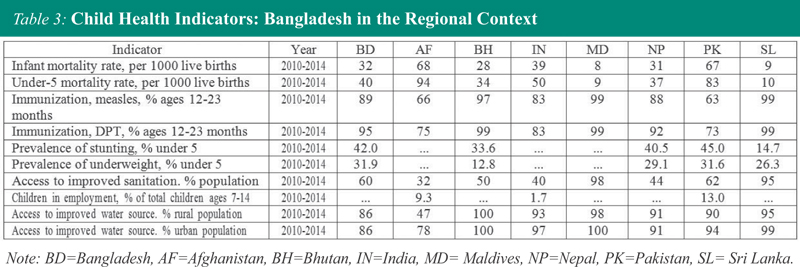
While strategies for providing flexible skills and enhancing employability of the existing labour force are difficult to implement within a comprehensive approach, the scope is wide for the children who are the potential entrants of the future labour force. For the approach, the challenge is to put the required emphasis on early education and health of the children with emphasis on both cognitive and non-cognitive skills. The aim should be to develop and enlarge the human-capital profile of the future labour force.
While the government has put emphasis on expanding the preprimary education along with primary education for all, the approach should also enhance the quality and equity aspects of education and incorporate the comprehensive elements of a successful skills-development strategy covering the entire life-cycles of the future labour force. As we have noted, the central role in the approach is the development of soft skills, which needs to start at the preprimary level. This requires a close coordination between preprimary schooling and child-health initiatives, the two central pillars of early childhood development. Bangladesh can also learn from success stories of early childhood development and their employability/productivity implications in later-life working age from other countries, such as South Korea.
The writer is an Executive Director, Institute for Inclusive Finance and Development (InM). [email protected]
© 2024 - All Rights with The Financial Express
